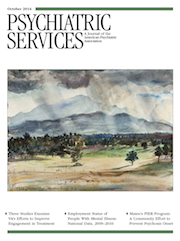Reduction in Incidence of Hospitalizations for Psychotic Episodes Through Early Identification and Intervention
Abstract
Objective
This study examined whether the incidence of hospitalization for psychosis was reduced by a communitywide system of early identification and intervention to prevent onset of psychosis.
Methods
The Portland Identification and Early Referral program (PIER) was initiated in 2001. Youths and young adults ages 12–35 were identified by professionals in a wide variety of educational, health, and mental health settings. PIER program staff assessed, confirmed risk of psychosis, and provided treatment for 24 months to eligible and consenting young people (N=148). The monthly rate of first hospital admission for psychosis was the outcome measure for efficacy of identification and intervention. Admission rates before and after the program began accepting referrals were compared, both in the experimental area (Greater Portland) and in aggregated urban areas of Maine (control areas). Autoregressive integrated moving-average (ARIMA) models were used to assess the effect.
Results
On the basis of ARIMA models, the rate of first hospital admission for psychosis decreased significantly by 26% (95% confidence interval [CI]=–64% to –11%) in the Greater Portland area. The rate increased by 8% (CI=–5% to 36%) in the control areas. Taking into account the increase in the control areas, the actual percentage reduction in Greater Portland during the intervention period was 34% (26% plus 8%). The reduction in admissions was largest for individuals with nonaffective nonschizophrenic psychosis.
Conclusions
PIER has demonstrated that populationwide early identification is feasible. Preventive intervention can reduce rates of initial hospitalizations for psychosis in a midsized city.



